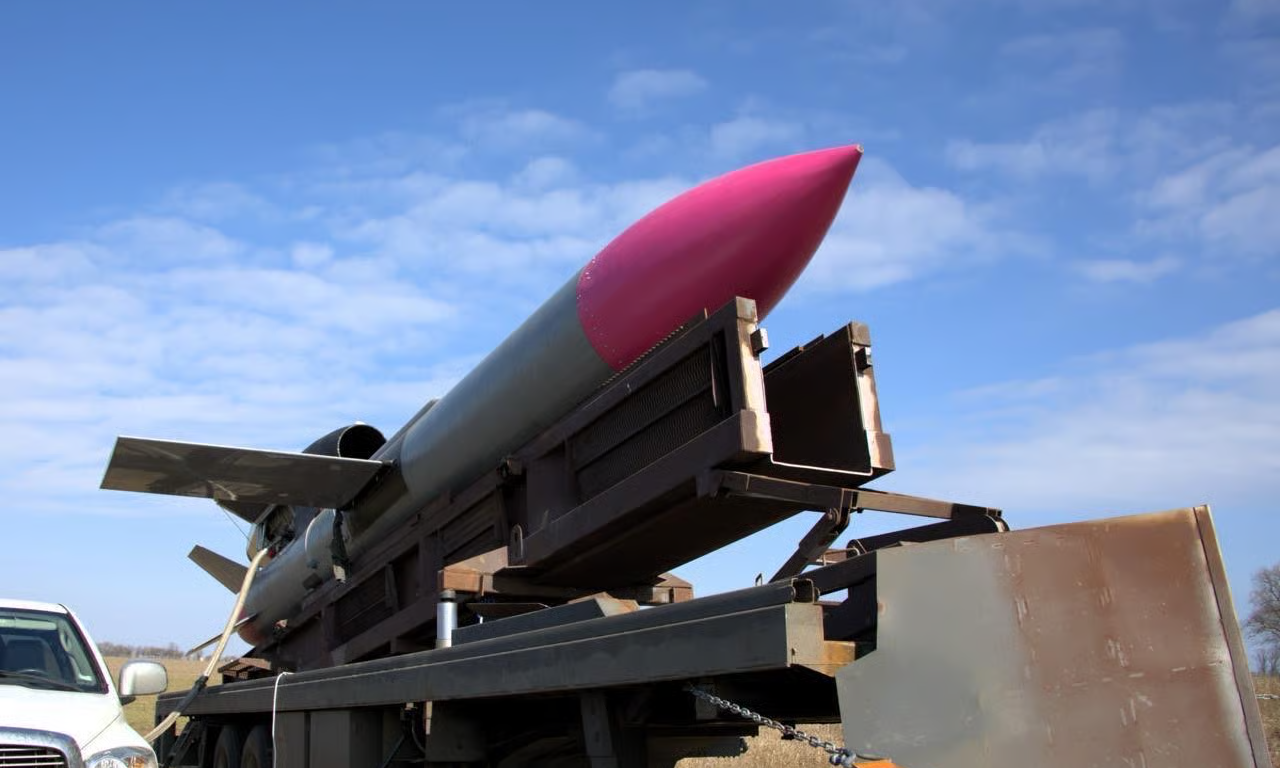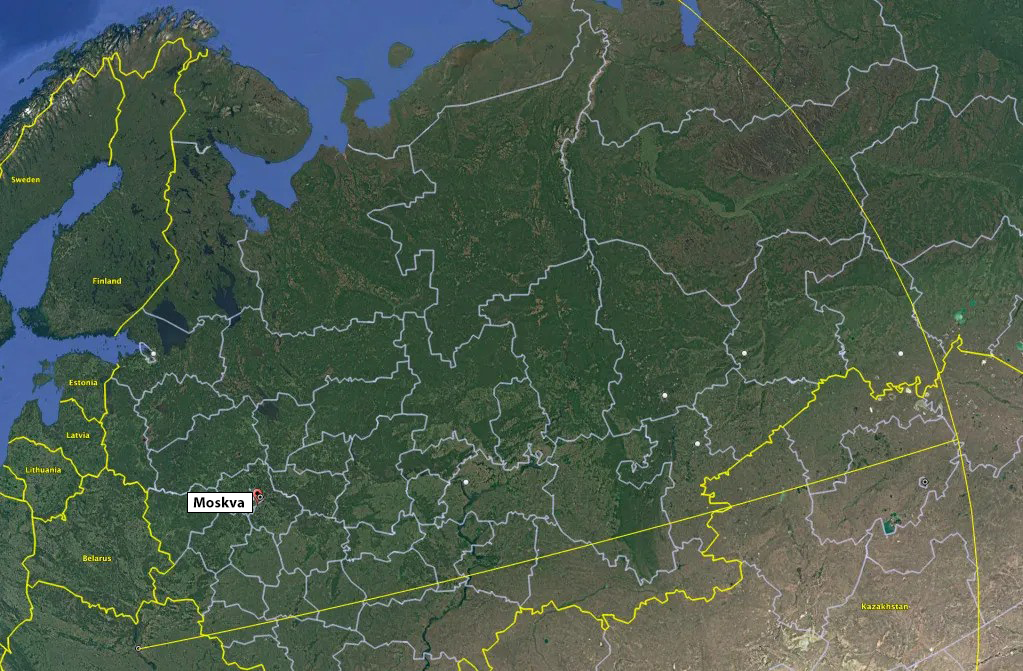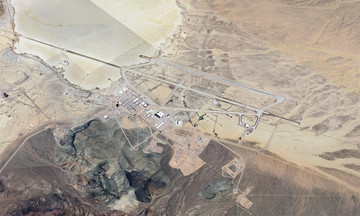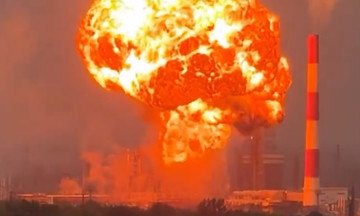Ukrainian startup Fire Point recently unveiled its new cruise missile, Flamingo, boasting a 3,000 km range and a 1,150 kg warhead.
The missile's name originates from the pink color initially applied to its warhead section. Iryna Terekh, Fire Point's CEO and technical director, explained that this was a tribute to the lead female engineer in the missile's production, a field typically dominated by men. The engineer's identity remains undisclosed.
"The first missiles were all pink and passed every test in that color. However, we had to switch to a different color for military camouflage purposes. Nevertheless, the woman responsible for production is still there. This is the female mark on the missile," Terekh emphasized.
 |
The Flamingo missile with its pink nose cone in a photo released on 21/8. Photo: Fire Point |
The Flamingo missile with its pink nose cone in a photo released on 21/8. Photo: Fire Point
Ukrainian President Volodymyr Zelensky announced last week that the Flamingo missile had been successfully tested and is slated for mass production by February 2026.
"This is Ukraine's most successful missile. We will have more by December," Zelensky stated.
Observers and media in both Russia and Ukraine have noted the missile's striking resemblance to the FP-5 cruise missile, unveiled by the UAE's Milanion Group at a defense exhibition in Abu Dhabi last February.
The FP-5 features a one-ton warhead, a maximum range of 3,000 km, a launch weight of 6 tons, a 6-meter wingspan, a top speed of 900 km/h, and utilizes inertial and satellite navigation with anti-jamming capabilities. Sketches released by the UAE also show the FP-5 using a similar launcher to the Flamingo.
Alexander Stepanov, a military expert at the Russian Institute of Law and National Security, suggests this indicates Ukraine is "rebranding" foreign weapons technology as domestic products.
Russia's TASS news agency also believes the FP-5's design suits entities lacking the resources for full production. They could simply import pre-fabricated parts and modules for final assembly.
However, Ukraine denies these claims. "We have observed the Russian reaction to the missile's first missions. The more successful the mission, the more Russia tries to suppress information about it," Terekh said.
Fire Point previously stated that the Flamingo had been used to strike targets within Russia and released launch videos, but without footage of the terminal phase.
Two Flamingo missile launches in videos released on 18/8. Video: Dzerkalo Tyzhnia
Regardless of its origins, this weapon could significantly benefit the Ukrainian military. Fabian Hoffmann, a missile expert at the University of Oslo, Norway, notes that the Flamingo's destructive power far exceeds Ukraine's long-range UAVs.
UAVs can only carry small payloads, making it challenging to completely destroy targets like oil refineries, power plants, logistics centers, and military airfields within Russian territory.
Larger weapons can have a much greater impact. In June, Ukraine used an R-360 Neptune missile with a 150 kg warhead to attack an oil refinery in Russia's Krasnodar region, causing a three-day fire.
With its one-ton warhead and high terminal velocity, the Flamingo is expected to penetrate deep into targets before detonating, significantly increasing its destructive power. Its blast radius also surpasses that of Ukraine's existing missiles and UAVs.
"This is Ukraine's strongest security guarantee. If they can deploy 3,000-5,000 of these missiles, ready to launch within 24-48 hours to destroy 25% of Russia's economy, it would be difficult for Moscow to sustain its campaign," Hoffman stated.
Fire Point claims to be producing about one Flamingo missile per day and aims to increase production sevenfold by October, meaning over 2,500 missiles annually.
Factory images suggest the Flamingo uses the Soviet-developed AI-25TL turbofan engine, also found in the L-39 Albatros training aircraft. This seems logical, as Ukraine's Motor Sich company still produces AI-25 engines, and the Ukrainian military operates L-39s.
Crucially, the L-39 is widely used globally, with thousands produced, providing Ukraine with a potential engine supply and boosting production speed.
Even if they fall short of this goal and produce only 360-600 missiles per year, Ukraine would likely still possess enough heavy cruise missiles to significantly impact the war, according to Hoffman.
 |
Flamingo missiles at the Fire Point production facility on 18/8. Photo: AP |
Flamingo missiles at the Fire Point production facility on 18/8. Photo: AP
With its 3,000 km range, the Flamingo can cover all of Russia's European territory, home to about 80% of its population. It can threaten targets in central Russia, including Moscow and St. Petersburg, and even reach parts of Siberia.
However, Terekh insists the Flamingo is not designed to attack such symbolic cities. "The company was founded in response to Russia's campaign, but we do not intend to be aggressive, only to protect our national sovereignty," she said.
The Flamingo's guidance technology and stealth capabilities against Russian air defenses remain unclear.
Gustav Gressel, an Austrian military expert, believes the Flamingo won't match the stealth and maneuverability of Germany's Taurus system, but its long range and large warhead will make it highly effective.
The Flamingo's announcement comes as Washington appears to have imposed restrictions on Ukrainian strikes deep into Russia using Western-supplied long-range missiles.
The Wall Street Journal reported last weekend that the Pentagon has secretly established a new approval process for Ukraine's use of US-made long-range weapons, or European ones reliant on US intelligence and components.
This process has prevented Ukraine from firing ATACMS ballistic missiles into Russian territory since late spring.
President Zelensky declared on 24/8 that Ukraine can now strike deep into Russia without prior US consultation, thanks to the Flamingo's development. "We are using domestically produced long-range weapons and have not recently discussed this issue with the US," he said.
 |
The range of the Flamingo missile when launched from central Ukraine. Graphic: War Zone |
The range of the Flamingo missile when launched from central Ukraine. Graphic: War Zone
Pham Giang (According to Euronews, Politico, WSJ)












